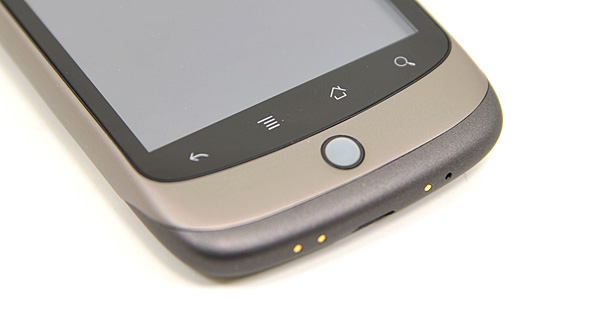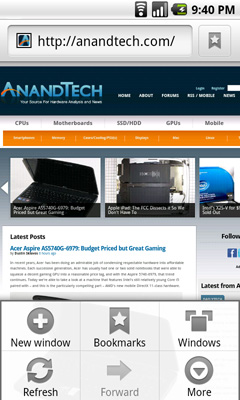Anand's Google Nexus One Review
by Anand Lal Shimpi on April 3, 2010 3:40 AM EST- Posted in
- Smartphones
- Mobile
The Home Bar
The Nexus One has three physical buttons: a power/lock button at the top, volume rocker on the left side and a trackball/button on the face.

The trackball is mostly useless. The Nexus One has a 3.7” multitouch screen for a reason, and it’s way quicker to use the screen than to use the trackpad for scrolling. There are some limited situations where the trackball can be useful, for example while playing games. The iPhone has no useful physical buttons for gaming, the Nexus One’s trackball is better for moving a character around than a virtual d-pad.
Above the trackball there are four touch buttons with fixed functions: back, menu, home and search. By default all provide haptic feedback when activated. In other words, they vibrate a bit when you touch them. It’s a fine feature but it’s nowhere near the feedback you get from physical buttons if that sort of thing matters to you. The buttons also give you the same feedback regardless of whether or not their operation is permitted in the current mode (e.g. hitting the contextual menu button when no such menu exists).
The back button is useful and works as intended, it goes back a screen. The menu button takes some getting used to. The best way I can describe it is like a right click. You get a contextual menu depending on what app you’re running. At the home screen it lets you pop into Android’s settings, add application shortcuts, change wallpaper, view notifications and search. In the email app the contextual menu lets you refresh your inbox, switch to a different folder, change settings, etc...

The contextual menu in Android's Browser app
This is where Android’s more PC-side comes out to play. Apple and Palm for the most part try to keep these sorts of menus away from you. Apps are purposefully not very deep and settings are all controlled through the settings screen, not from within an app. Functionality is driven by the UI. Android takes a more application centric approach. Neither is right or wrong, but both approaches have their pros and cons. I’d argue that Apple/Palm’s approach is better suited for something that’s going to be used as a passive device. Something you’re quickly scanning emails or text messages on. Google’s take is more PC-like. Give the users the options they want, where they want them, even at the risk of UI simplicity.
The Apple method runs the risk of limiting functionality, while Google’s risks turning the UI into a cumbersome mess. Neither is there today, but left unchecked that’s where they’d end up.
Moving on, the home button works as expected, it takes you to your home screen. The search button is particularly interesting because it is one Android feature that Microsoft copied in Windows Phone 7. Hitting the search button brings up an autocomplete enabled Google search box. Hitting go, launches the web browser (very quickly thanks to Mr. Snapdragon) and displays your search results.

What MS is proposing for WP7 are contextual search results that are formatted for the smartphone. Akin to a search app if you will. Search for GeForce GTX 480 and get a normal listing of websites. Search for dentists and get a smartphone formatted list of dentists in your area. Granted MS’ proposal is just that, a proposal, while Android is shipping today. Enabling similar functionality though shouldn’t be hard for Google. I’d love to be able to search, pull results from the web, but have the results presented as more of an app.

Windows Phone 7 Search
The search function will autocomplete things like address book entries, but it won’t automatically search your email for you. While the iPhone’s search function is more focused on searching your device, Android is more interested in helping you search the web. Google has a search engine, Apple doesn’t, the distinction makes sense.










95 Comments
View All Comments
xtremevarun - Saturday, April 3, 2010 - link
Reviews of Nexus One on other sites were not as comprehensive as on Anandtech. You guys really explored all the features. Apple needs to do a major refresh to iPhone. And I do see Android becoming a major, major OS for phones if it's not already. WinMo7 also looks great. Good that competition is hotting up against the iPhone.xxNIBxx - Saturday, April 3, 2010 - link
What about Samsung's Bada OS? Samsung Wave s8500 beats the living crap out of all those Snapdragon devices. Also Samsung will release i9000 Galaxy S, which has pretty much the same hardware as with s8500, except it runs Android. Hardware wise, these 2 are the best phones in the world. Snapdragon is old news.Iphone 4g, which will come out in 2 months, will most likely use apple's a4, which from what i hear, is probably identical to samsung's 1ghz cpu(same cpu/gpu)/
sprockkets - Saturday, April 3, 2010 - link
If you receive a call over BT, does it1. Play the ringtone over the headset?
2. Play it on the headset only or both the speaker and headset?
3. Announce CID over the headset or even just the speaker?
sushantsharma - Saturday, April 3, 2010 - link
Looks OK! But usability should not go for a toss! Or I am missing it and it is there?Chloiber - Saturday, April 3, 2010 - link
"It's got a Qualcomm Snapdragon QSD8650 SoC"Thought the Nexus One (and the HTC Desire) use a Snapdragon QSD8250?!
Anand Lal Shimpi - Saturday, April 3, 2010 - link
You are correct :) Fixed!Take care,
Anand
Karl Brown - Saturday, April 3, 2010 - link
I will be receiving my Sony X10 on Tuesday.I hope the Sony will offer enough of the Nexus One's functionality to not make me regret not waiting longer for the Nexus One to become available in the UK.
jasperjones - Saturday, April 3, 2010 - link
Thanks for the very thorough review. The one area were the review lacks depth is audio and video playback and syncing. Differences in this area are striking imo:1.) If you don't use iTunes as an iPhone owner, you're pretty much SOL. The Nexus One I could sync with iTunes using DoubleTwist. But I don't like iTunes. I can just use Explorer or Windows Media Player or Songbird (1.7 beta) to sync instead. The latest Songbird builds do an amazing job (they even converts WAV and FLAC files on-the-fly).
2.) Formats. I like that the the Nexus One supports OGG. FLAC support is coming (AFAIK it got added to trunk some time ago--idk if users will see it in FroYo or Gingerbread) Plus the Nexus One gives me everything the iPhone has (including M4A).
3.) The media player. I hate to admit it as a current Nexus One and previous iPhone owner, but here the iPhone with its iPod app wins hands down. The UI of the iPod app is infinitely more intuitive, whereas things such as playlist generation are a pain on Android (everything takes far too many clicks).
Because of 3.), I think the overall win in this category goes to the iPhone.
bstewart - Saturday, April 3, 2010 - link
Outstanding review - really enjoyed your detailed assessment of the Nexus one compared to the IPone and Palm Pre. I have read a number of reviews on the Nexus one lately determining if it is the right device for me or not. After reading this review I am certainly more inclined to purchase it than before; especially based on it's pros and cons versus the IPhone. Thanks!Brian
cj100570 - Saturday, April 3, 2010 - link
All in all I'm not feeling this review. There was way to much time spent comparing the Nexus to the iPhone. And your complaints about the notification system used by Android is just asinine. I'm the former owner of both an original and 3G iPhone and Android simply puts the iPhone OS to shame. The iPhone had it's 15 minutes of fame but it's time to face facts that Apples way of doing things is the biggest problem the iPhone has. As a smartphone it is a #FAIL. Sure it sells well but the honest truth is that most people buy it because it's an Apple product and because of all the apps, 80% useless, that Apple and AT&T trot out as the big selling point.